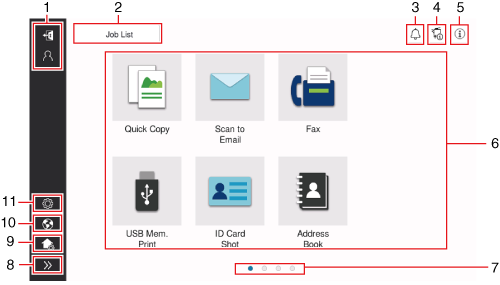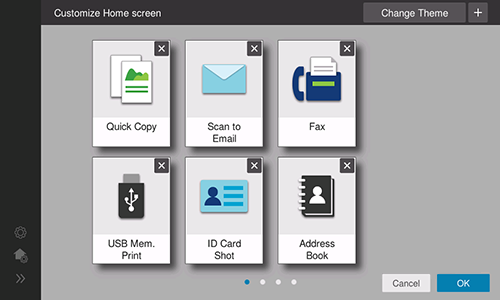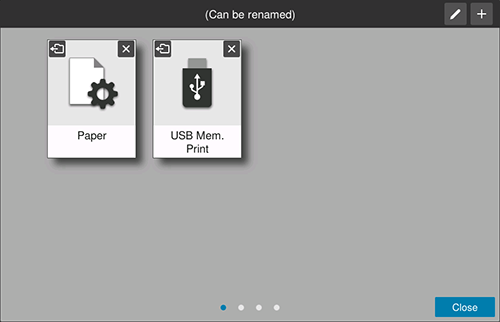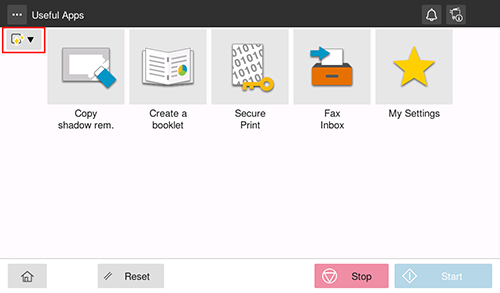
Home Screen
Layout of home screen
The layout of the home screen is as follows.

No. | Name | Description |
|---|---|---|
1 | User/Account Name | Displayed when user authentication and account track are enabled. Opening the left area displays the name of the current login user or the account name. Tap the log-out icon ( |
2 | [Job List] | Displays active or standby jobs. If necessary, you can check job logs or print a communication report. This list displays the operation status of the current job on the [Job List] key when it is running. If necessary, you can stop the active job using the Stop key displayed next to the [Job List] key. For details on [Job List], refer to Job Screen. |
3 | Notification icon | You can check warnings or notices related to the status of this machine. |
4 | Device information icon | You can check the current date and time, free space in memory, and toner level. The corresponding device information is displayed when:
|
5 | Information icon | Displays a message for users. |
6 | Function key | Displays shortcut keys assigned to any function. |
7 | Page Indicator | You can check the currently displayed page number. |
8 | Left area open/close icon | Opens or closes the left area. Opening the left area displays the names of the icons in the left area. |
9 | [Customize Home screen] | Sets the function keys to display on the home screen. |
10 | [Language] | Temporarily changes the language to be displayed on the panel. This option is displayed when [Temporarily Change Language] is set to ON in [Utility] - [Administrator] - [System Settings] - [Temporarily Change Language]. |
11 | [Utility] | Configure settings of this machine or check the use status of this machine. For details on [Utility], refer to Utility. |
Changing a function to be displayed on the home screen
Change the function keys displayed on the home screen to suit your environment.
When the Personalize application is installed, you can change the function keys displayed on the home screen, for each login user.
When you are logging in as a user with the administrator authority, proceed to step 3.
The display changes to the edit mode of the home screen.

To switch the page on the home screen, swipe the background of the screen.
In [Change Theme], you can change the theme such as the background color of the home screen.
To delete a function key, tap the delete icon (
 ) of a function key.
) of a function key.To add a function key, tap the add icon (
 ). Select the target function key from the list, and tap [OK]. The function key is added to the currently displayed page. If there is no space to place an additional function key on the current page, the function key is placed on a new page.
). Select the target function key from the list, and tap [OK]. The function key is added to the currently displayed page. If there is no space to place an additional function key on the current page, the function key is placed on a new page.Dragging & dropping a function key allows you to change the layout of function keys on a page or move a function key to another page.
If you drag a function key and drop it on top of another function key, the function keys are grouped, which causes a folder to be created.

- If the OpenAPI application is registered on this machine, you can arrange keys for the registered applications or registered application groups in the home screen. For details, contact your service representative.
Grouping function keys
You can group function keys into a folder.
 ).
).A folder is added to the currently displayed page.

To add a function key, tap the add icon (
 ). Select the target function key from the list, and tap [OK]. The function key is added to the currently displayed page. If there is no space to place an additional function key on the current page, the function key is placed on a new page.
). Select the target function key from the list, and tap [OK]. The function key is added to the currently displayed page. If there is no space to place an additional function key on the current page, the function key is placed on a new page.To delete a function key, tap the delete icon (
 ) of a function key.
) of a function key.To eject a function key from a folder and move it to the home screen, tap the function key eject icon (
 ).
).To edit the folder name, tap the edit icon (
 ) or the folder name display area.
) or the folder name display area.

- Up to 32 function keys can be arranged in a folder.
- Folders with no function keys are not displayed on the home screen.
Accessing all the function keys
You can tap [Useful Apps] on the home screen to group and display the function keys that can be arranged on the home screen by function and search for the desired function key. You can also access all function keys installed in this machine, including function keys that are not arranged on the home screen.

To display only the function keys that are not arranged on the home screen, select [Home screen unassigned apps].
To display all the function keys, select [All].

- To set the currently selected type as the default when the [Useful Apps] screen is displayed, tap [Set the current Apps List as the default display] from the Menu icon (
 ).
).
 ) to log out.
) to log out.
 in the upper-right of a page, it turns into
in the upper-right of a page, it turns into  and is registered as a bookmark.
and is registered as a bookmark.